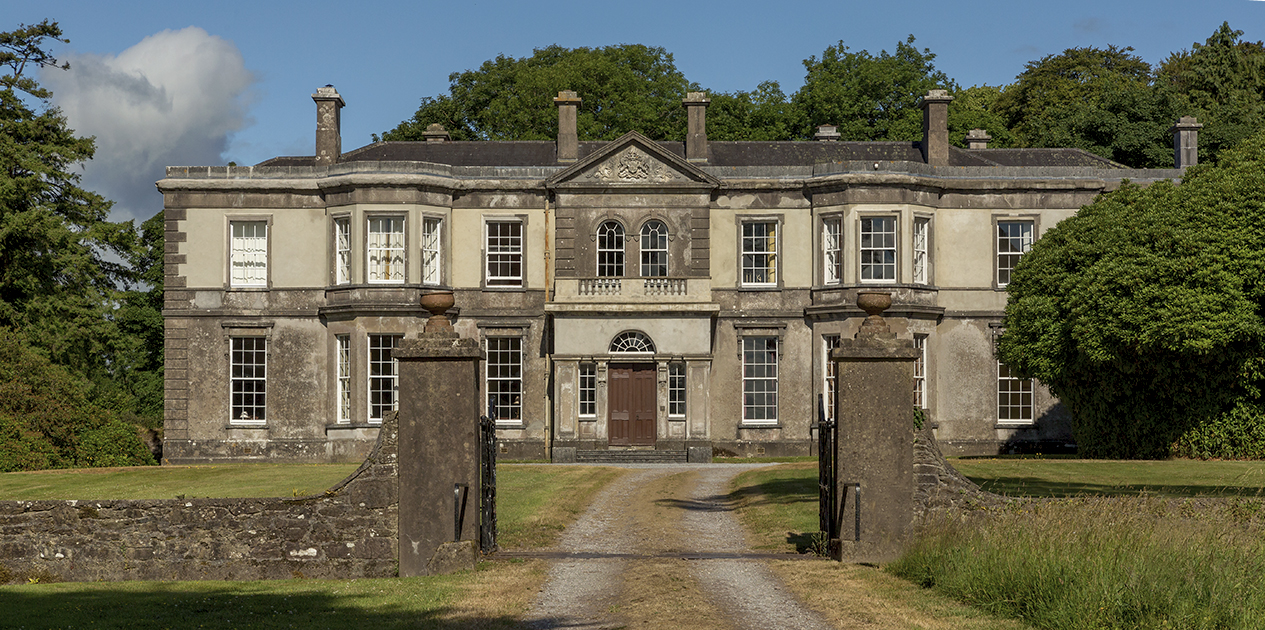Glenville Park
Glenville Park, in County Cork, sits at the centre of a large inverted triangle with the city of Cork and the towns of Fermoy and Mallow at its apices. The house, which at various times has been known as The Manor, Glenville, and Mount Pleasant, was originally a seat of the Coppinger family and was built on estates they had acquired from the O’Keeffe clan, the chief sept of the region. Their two-storey eighteenth century house had five bays of blocked Gibbsian architraves and a semicircular forecourt with gates at either side, which still exists at the north front of the present house, adjoining the large walled garden.
Dr Edward Hudson, who purchased the estate in the late 1770s, built a large new three storey east-facing range at right angles to the original building. This was given a three-bay pedimented breakfront, with a central door case and fanlight and matching single bay, two storey wings.
Initially, Glenville was inherited by his eldest son, the dean of Armagh, before passing to the second son, William Elliot Hudson (1796-1853), a barrister, musician and patriot with a particular interest in Irish literature. Along with his younger brother Henry, Hudson was also an important collector, who performed the important task of transcribing traditional Irish songs and melodies from the oral tradition. Today he is remembered as the composer of the music for “The Memory of The Dead” now usually known as “Who fears to speak of ’98”.
Hudson and his younger brother both died childless and Glenville was inherited by their nephew, Edward (later Sir Edward) Hudson-Kinahan, who further extended the house when granted a baronetcy in 1887. His architect, Sandham Symes, created a new two storey building along the entire front of the late-eighteenth century range, effectively doubling the depth of the house, extending it considerably, and facing the whole building in grey cement. The result was a long, twelve-bay front in a late Victorian version of the Georgian style with two double height half-hexagonal bows, while the Hudson-Kinihan arms are displayed in the pediment of the unusally arranged central breakfront.
Symes also rearranged the earlier interior as a two storey structure without reducing the overall height, which ensured that the high ceilings of the new building continue throughout the house.
The rooms are largely unaltered. A long hall central bisects the house and culminates in the main staircase, which raises to a substantial landing at the upper level. Half way down the hall an elliptical arch, with fine Victorian plasterwork, marks the division between the two stages of the building, while the doors to the principal reception rooms are surmounted by decorative segmental pediments. The main rooms contain original chimneypieces and wall paper, and good Victorian plasterwork, while the remainder of the interior "rambles in an agreeably disordered fashion".
Outside, the garden contains old beech hedges and walls of faded pink brick. The Glen garden includes some spectacular rhododendrons and azaleas, along with other specimen shrubs and trees, which can best be appreciated from the newly created woodland walk.
The Hudson-Kinahan family died out with the third baronet, Sir Robert, and the house became the home of Colonel Philip Bence-Jones and his wife, who purchased Glenville from the trustees in 1949. The Bence-Jones family, who originally came from Lisselane, near Clonakilty in West Cork, were looking for a new home after their house, Annemount on Cork Harbour, had been destroyed by fire.
Their alterations include the installation of a chapel, created by combining three small rooms, with stained class windows by Stanley Tomlin and Patrick Pollen. Above the stone altar, by Seamus Murphy, is a statue of the Madonna. Its survival from the Annemount fire is reputed to be a miracle.
Mark Bence-Jones, their only child, was an important Anglo-Irish author, historian, genealogist and 'man of letters', whose prolific works are an important record of Irish and English country houses and their owners. Mark was also a prominent Knight of Malta and Chancellor of the Knight’s Irish Association.
On his death Glenville passed to his younger daughter, Silvia, whose home it is today.
Address & Contact
Glenville Park, Glenville, Corkt: +353 21 4880103
m: +353 86 8453539
e: silviabencejones@hotmail.com
Available as a Film Location
Houses and Garden
Individual Garden Visitors
Culture and Education
Concerts, Plays or Recitals
Courses for Adults
Accommodation and Short Breaks
Overnight with Dinner
Events
Special family celebrations
Meetings or receptions
Additional Information
Join us for yoga and a nutritious lunch at lovely Glenville Park. Followed by a tour of the house and gardens.
50 euro per person. October 23rd 2021 at 10.30.
For bookings, please call: 0868374502


